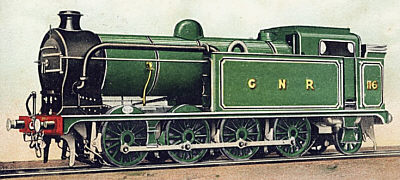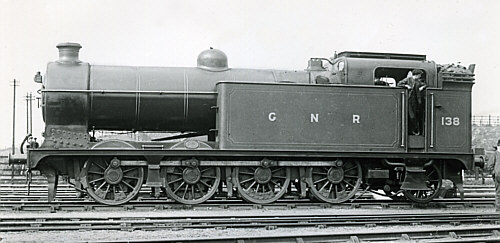The Ivatt R1 0-8-2 Tank Locomotives

Ivatt's C12 suburban tank engines were successful in that they had a greater capacity than Stirling's G1s and G2s, which they replaced. However, they were still limited by the adhesion of the 4-coupled design. Ivatt solved this in 1903, by ordering a prototype 0-8-2T tank locomotive. Given the GNR designation of Class L1 (LNER R1), this new locomotive was essentially a tank version of his Q1 0-8-0 tender locomotive.
Unfortunately, this prototype was too heavy for the intended Metropolitan City Lines, so it was quickly rebuilt with a smaller boiler and shorter side tanks. Ten more engines were ordered to this modified design, and all eleven started working the suburban services out of King's Cross. Whilst operating these services, these engines demonstrated a very fast acceleration to 30mph but probably never went much faster than 40mph or so. Thirty more engines were built in 1905 and 1906. The original engines were not a great success in the London area, so these new locomotives worked goods trains in the West Riding. In 1907, the original eleven engines moved to the West Riding to also work goods trains.

There was no need for the smaller boiler after the move from the Metropolitan City Lines, so between 1909 and 1926, they were rebuilt with the original Q1-type boilers. Many of these boilers were taken from Q1s when they were rebuilt with superheated boilers. During the rebuilds, seven R1 locomotives had superheaters fitted but had their working pressure reduced to 170psi.
During the period of small boilers, the R1s had their cylinders lined to 18in to match the boilers.

In early 1932, there was a proposal to convert some of the R1s to diesel-engined compressed air locomotives. Three different designs were considered, but they were essentially the same. The frames, valves, and wheels would have been kept, but the cylinders would have been lined to 18in. A 400hp 8-cylinder diesel engine would have been in the middle, and would have powered a 4-cylinder air compressor. An air reservoir would have been at the back, with the cab located at the front. Air was taken from the reservoir and heated by the diesel exhaust and an oil-fired steam generator, before entering the cylinders at about 150psi. This project was dropped due to the Depression and the projected expense.
The first engine was withdrawn in 1927, and the class survived until 1934. The boilers from Nos. 3138 and 3148 were kept at Doncaster, and were eventually sold for scrap in 1966.
Technical Details
The following details are for the saturated boilers. The locomotives with superheated boilers had slightly smaller heating surfaces, a boiler pressure of 170psi, and a weight of 75 tones 4cwt (full).
| Cylinders (x2): | 20x26in. | |
| Boiler: | Diameter: | 4ft 8in |
| Length: | 14ft 8 5/8in | |
| Pressure: | 175 lb/sq.in | |
| Heating Surface: | Total: | 1439 sq.ft. |
| Firebox: | 137 sq.ft. | |
| Tubes: | 1302 sq.ft. | |
| Wheels: | Coupled: | 4ft 8in |
| Trailing: | 3ft 8in | |
| Total Wheelbase: | 25ft 2in | |
| Tractive Effort: | 27,626 lb | |
| Length: | 38ft 7.25in | |
| Weight: | (full) | 71t 7cwt |
| Max. Axle Load: | 15t 5cwt | |
| Water Capacity: | 1500 gallons | |
| Coal Capacity: | 2t 10cwt |
Preservation
All of the R1s were withdrawn by 1934. None survived into preservation.
Models
I am not aware of any models of the R1 in any scale.
Acknowledgements
Thank you to Mike Morant Collection for the colour illustration of R1 No. 116.
Thank you to David Hey for the photograph of GNR No. 138.